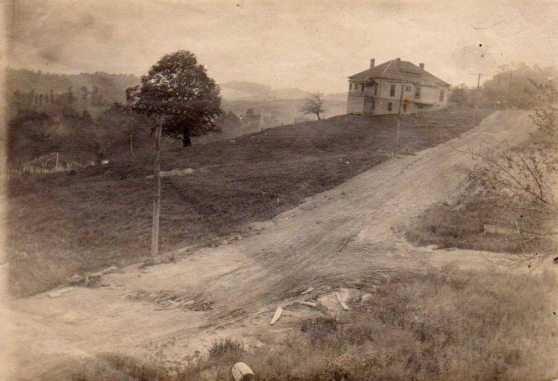
701 Milford was built about 1911 for Harry and Bessie (Lorenz) Wade. The house is on lots 65 and 66 of Hartland Addition, which was subdivided in 1910 from land bought from James Irvin Sampson Stealey which was his portion of his father Edmund Stealey’s land. Lot 66, the corner lot, was originally purchased by Harry Wilson in June 1910, who sold for $500 cash and assumption of $600 in notes, to the Wades in October 1910, who bought Lot 65 from Hartland Improvement at the same time, for $350. Harry Wilson bought Lots 61, 62, 63 and 64 the next week, suggesting he was speculating. By 1913, he had conveyed Lots 63 and 64 to Joseph Stealey, who held his notes. Lot 64 was resold immediately to Gay Lynch Osborn, who reconveyed it to Mabel Stealey in 1922. Lot 63 was resold to Elizabeth Thompson and reconveyed to Stealey in 1917. Neither lot was built on. The subdivision deeds carried a restriction against selling or leasing to any “negro, Italian, or Syrian” for 50 years. The Wades sold to Mollie Nusbaum, wife of Emmanuel “Mannie” Nusbaum, who had a clothing store in downtown Clarksburg, in April 1919. By the 1920 census, Harry and Bessie Wade were renting a house on Meigs Avenue and taking in boarders; he was listed as a traveling salesman. In June 1920, Mrs. Nusbaum sold the house to Loring and Norma Smith Tonkin, who had been renting it, for $10,000.
Jacob Stahli, one of the early settlers of Clarksburg, bought a large parcel for his son Edmund that included the present Stealey neighborhood as well as the Hartland Addition. Edmund’s original Stealey house, on the site of the present Rich gas station on Milford Street, was built in 1786 by Nicholas Carpenter, who in 1784 took out the original grant on the land, which he had settled in 1772. Original grant page 1 and page 2
Nicholas Carpenter, my 6th great-grandfather, whose name was a translation of Zimmerman, was Swiss, as was Jacob Stahli. I am his descendant twice through his daughter Catherine, who married David Wallace Sleeth. Their son Alexander Sleeth married Catherine Wolfe, who married William Harrison Snider, and their daughter was my great-great-grandmother Columbia “Molly” Snider, wife of Lorenzo Dow McVaney. Their son, John McVaney, married Mary Elizabeth “Mollie” Snider, who was a great-granddaughter of Alexander Sleeth’s sister Catherine. John McVaney moved to Clarksburg from Gilmer Co., as did his wife’s parents, Samuel Brannon Snider and Louisa Jane Edwards in the 1910s. The Sniders are buried in the Masonic Cemetery and the McVaneys in the Odd Fellows cemetery.
The house is at the western edge of what is now known as the Stealey Addition, a neighborhood above the West Fork River southwest of the original center of Clarksburg. Milford Street is now U.S. Route 19, the main road to Weston, but when the house was built, the main road south ran along Chestnut Street and down Lost Creek Road, on the other side of the river.
In the 1920 Census, Loring Tonkin and his family are listed as renters at 701 Milford, with three young children. There are still very few houses in the neighborhood. The nearest neighbors, across Hartland Avenue at 613 Milford, were Philip Steptoe, a lawyer, his wife Mary and young children. Across the street at 617 Milford were William Rogers, a lumberman, his wife Mary, and their children.
The Tonkins added dormers to make the half-story upstairs bedrooms and bath, and a maid’s room with bath in the basement, in 1924. In 1930, Loring and Norma are listed as owning a house worth $15,000 at that address. The arched interior doorways, stone terrace, and paneled library with stone chimney were added in 1939, the year Mr. Tonkin became president of the Hope. In 1946, the Tonkins purchased the next two lots (63 and 64) downhill on Hartland Avenue, from Mabel Stealey. Mr. Tonkin died in 1953, and after Mrs. Tonkin died in 1961, their only son, John, inherited the house. In 1978, it was bought by Irvin and Marie Miller.
View Google Map with Street View
The Wades
Harry Wade was the son of the Rev. Thomas S. Wade, D.D., who was the last minister of the Methodist Episcopal Church, South, in West Milford, which discontinued services in 1910. He and his parents were living with his mother Ella’s parents, E. B. and Margaret Hursey on Pike Street downtown, in 1900, before he and Bessie married in 1903, and he and Bessie were living next door in 1910, with her mother. He was working as a bookkeeper in 1900, and listed as a commercial traveler in 1910. They moved to Marshall Street before 1930, and he continued to work as a salesman. Harry died in 1956, and Bessie in 1971; they are buried in the Odd Fellows Cemetery.
The Tonkins
Loring Lombard Tonkin was the son of Capt. John and Mary Tonkin of Oil City, Pennsylvania, born in 1887. The first oil wells were drilled near Oil City, and it was the center of the early oil and gas industry. His father was originally from Missouri, president of the Central Kentucky Natural Gas Company, and an official of Standard Oil. (New York Times 16 Jul 1929) In 1903, Loring began working for Hope Natural Gas, originally a subsidiary of Standard Oil formed in 1898. Loring graduated from Cornell as a mechanical engineer. He eloped in the summer of 1913 with Norma Smith of Ithaca. That fall he was sued for alienation of affection by the millionaire ex-husband of a chorus girl with whom he apparently had a fling. The plaintiff eventually recovered 6 cents in damages after a second trial early in 1914. (See The New York Times coverage: 21 Jul 1913, 4 Dec 1913, 5 Dec 1913, 6 Dec 1913, 22 Jan 1914.) Mr. Tonkin was elected president and general manager of the Hope in 1939, and chairman of the board in 1951. He retired in 1952 and died the next year. (The New York Times obituary, 13 Dec 1953) His son John Barrett Tonkin was also an engineer and a Hope executive.
More Information
1930s Interior Design
Architectural Styles – The house seems to have started out as more or less as a vernacular house of no particular style, with a deep porch across the front, although it was well-built, with hardwood floors, plaster walls, and heavy framing. There was a brick fireplace in each original room, and the original lighting was gas, expanded to the upstairs when it was added in 1924. The lower back porch was originally enclosed, and the upper one, off the kitchen and master bedroom, was open. The upper porch was divided and enclosed to add to the kitchen and make a dressing room with a double closet, and the lower porch opened and enclosed with lattice, probably in the 1924 expansion. Central heat was added, probably in the 1939 addition, and a gas central air conditioner. The arched dormers, stone terrace, and paneled library with stone chimney, added in 1939, the year Mr. Tonkin became president of the Hope, show French Eclectic influence more than anything else.

Pingback: Windows, episode 1 « Koppantó
The house was built in 1912 or before. A photo taken from my grandfather’s home on Hartland Avenue when it was built shows the Tonkin home at the corner.